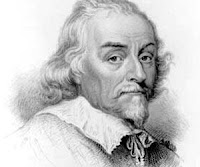 |
| William Harvey |
The human circulatory system represents the virtual definition of life. No system is more critical to our ex is tence. Yet only 400 years ago, no one understood our cir cu la tory system Many se ri ously thought that the thumping inside the chest was the voice of the conscience trying to be heard. Most thought that blood was cre ated in the liver and con sumed by the mus cles. Some still thought that ar ter ies were filled with air.
William Harvey discovered the actual function of the major elements of the circulatory system (heart, lungs, arteries and veins) and created the first complete and accurate picture of human blood cir cu la tion. Harvey was also the first to use the sci en tific method for bi o -log i cal stud ies. Ev ery sci en tist since has followed his ex am ple. Harvey’s 1628 book rep re -sents the beginning of modern physiology.
Through the six teenth century, doctors relied on the 1,500 year old writ ings of the Greek phy si cian Galen, who said that food was con verted into blood in the liver and was then consumed by the body for fuel. Most agreed that the blood that flowed through ar ter ies had no connection with the blood that flowed through veins. William Harvey was born in 1578 in England and received medical training at Oxford He was invited to study at Padua University in Italy, the ac knowl edged med i cal cen ter of Europe.
When Harvey returned to England in 1602, he mar ried the daughter of Queen Elizabeth’s doctor, was ap pointed a physi cian in the court of King James I, and was then ap -pointed personal physician to King Charles I in 1618.
While serv ing the English kings, Harvey focused his studies on veins and ar ter ies. He conducted extensive experiments with an i mals and human corpses. During these dissections he discovered the series of flap valves that exist throughout the veins. He was not the first to find these valves, but he was the first to note that they always directed blood flow toward the heart. Blood flowed in veins only from the arms, legs, and head back to the heart.
He began a series of animal ex per i ments in which he tied off a single artery or vein to see what happened Some times he clamped an artery and later released it to see where this surge of blood would go. He did the same with veins, clamp ing a vein and then re leas ing it. Some times he clamped both vein and artery and then released one at a time. These experiments proved that arteries and veins were con nected into a single circulatory system and that blood always flowed from arteries to veins.
Harvey turned to the heart itself and soon realized that the heart acted as a muscle and pushed blood out to lungs and out into ar ter ies. Fol low ing blood as it flowed through various animals, Harvey saw that blood was not consumed, but circulated over and over again through the sys tem, car ry ing air and nourishment to the body.
By 1625 Harvey had discovered an almost complete picture of the circulatory system. He faced two problems First, he couldn't figure out how blood got from an artery across to a vein, even though his ex per i ments proved that it did. (Harvey had no mi cro scope and so couldn't see blood vessels as small as cap il lary s By 1670—three years after Harvey’s death Italian Marcello Malpighi had dis cov ered capillary s with a microscope, thus completing Harvey’s circulatory system.)
The second prob lem Harvey faced was his fear of mob re ac tions, Church con dem nation when he said that the heart was just a mus cu lar pump and not the house of the soul and consciousness and the press (scribes). He was afraid he'd lose his job with the king. In 1628 Harvey found a small German publisher to publish a thin (72-page) summary of his work and dis cov er ies. He pub lished it in Latin (the language of science), hoping no one in England would read it.
News of Harvey’s book raced across Europe and made him instantly no to ri ous. He lost many pa tients, who were shocked by his claims. But Harvey’s sci ence was careful and accurate. By 1650 Harvey’s book had become the accepted text book on the cir cu la tory system.
Curtis, R. Great Lives: Med i cine. New York: Charles Scribner’s Sons Books for
Young Read ers, 1993.
Harvey, Wil liam. On the Mo tion of the Heart and Blood in An i mals. Whitefish, MT:
Kessinger Pub lish ing, 2005.
Power, D’Arcy. Wil liam Harvey: Mas ter of Med i cine. Whitefish, MT: Kessinger,
2005.
Shackleford, Joel. Wil liam Harvey and the Me chan ics of the Heart. New York: Ox ford
Uni ver sity Press, 2003.
Wyatt, Her vey. Wil liam Harvey: 1578 to 1657. Whitefish, MT: Kessinger, 2005.
Yount, Lisa. Wil liam Harvey: Dis cov erer of How Blood Cir cu lates. Berke ley Heights,
NJ: Enslow, 1998.


